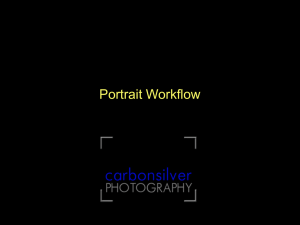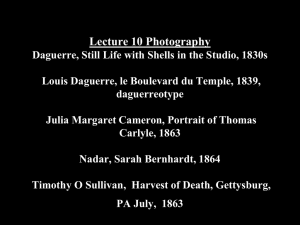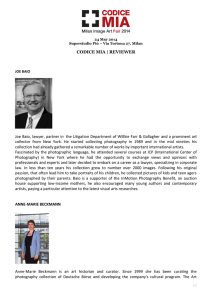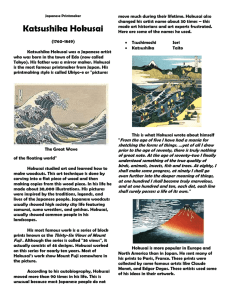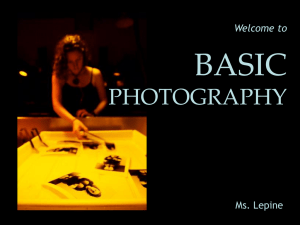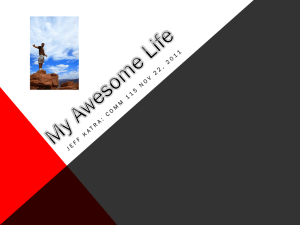Jeff Wall: Innovations from the Past
advertisement
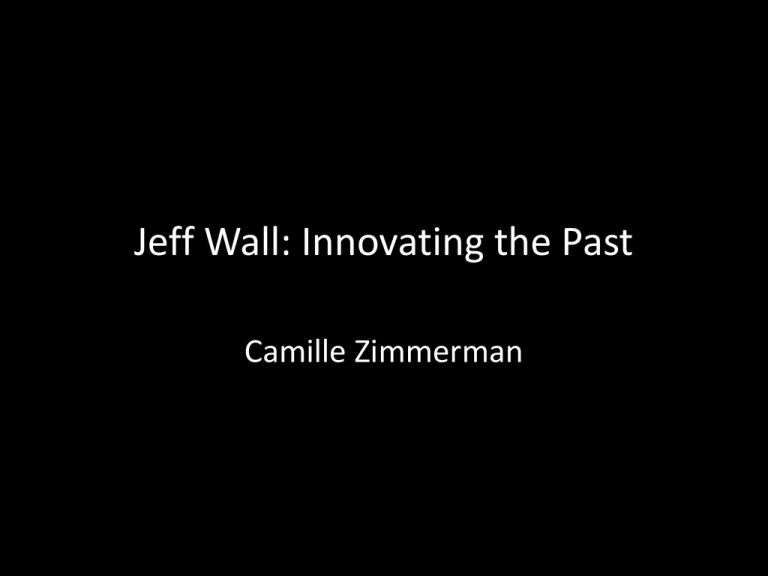
Jeff Wall: Innovating the Past Camille Zimmerman Mini Biography Jeff Wall, a graduate of the University of British Columbia, was trained as an art historian rather than a visual artist. After finishing his Master’s Degree, Wall stopped making art and began working as an Art History professor at the Nova Scotia College of Art and Design and Simon Fraser University. In fact, Wall did not even begin to rekindle his pursuit of the visual arts until seven years later in 1977. Once he began creating again, Wall started to experiment with installations, but is still best known for his incredibly large, staged photographs. Wall’s work takes influence from both well-know artwork and literature, as well as his own past life experiences. Atypical Photography: Wall’s Unorthodox Style Although a well-respect photographer in the art world, Jeff Wall’s work can hardly be classified among typical photographs. Wall disliked the traditional role of photography, and his work has continually rebelled against the characteristics generally found in photography. Two main things separate his work from the ‘typical’. The size of Wall’s work is much larger than traditional photography, and purposefully recalls the epic size of painted masterpieces such as works by Francisco Goya and Diego Velazquez. In an interview, Wall commented that he never liked the extremely small scale of most photography and he wanted to make a different statement than could be achieved through the constricting size of documentary photographs. “’I don’t like the traditional 8 by 10,’ he said…‘It’s too shrunken, too compressed. When you’re making things to go on a wall, as I do, that seems too small.’” (nytimes.com). Wall instead wanted to “make photographs that could be constructed and experienced the way paintings are…[that] engaged the viewer on a lifelike human scale” (nytimes.com). Continued from Previous Slide: Arguably the most important characteristic of Wall’s work is that it consistently rejects photography’s obsession with documentation. According to Wall, he was never interested in having to wait around in order to capture a fleeting moment; he would rather construct an event from memory. Wall has self-defined his own images as being “cinematographic”; meaning that his photographs are completely staged using actors, costumes, sets, and props. In an interview, Wall described his artistic process in the following way: “I begin by not photographing…if I see something on the street outside, I don’t photograph it” (Jeff Wall- “I begin by not photographing”). This attitude likely comes from Wall’s art historical educational background. Entranced by the imposing size and drama of old school painting, Wall takes direct influences from works by artists such as Gustave Caillebotte, Edouard Manet (an artist who Wall studied extensively at the Courtauld Institute), and Katsushika Hokusai among others. Some of his work even references well-known authors such as Franz Kafka and Ralph Ellison. Jeff Wall, A Sudden Gust of Wind (after Hokusai) (1993) The previous image is one of the best examples of Wall’s “cinematographic” photographs. A Sudden Gust of Wind (after Hokusai) is directly referencing a 19th colored woodblock print from the artist Katsushika Hokusai (following image). Hokusai’s image depicts several Japanese working men walking on a dirt path when they are suddenly overtaken by a strong wind. This wind releases one man’s papers flying through the air. Wall’s photograph is not identical to this work; Wall chooses to depict modern American businessmen instead of 19th century Japanese workers. I think this change was clever of Wall because it modernizes and makes familiar a work that is otherwise very foreign to current viewers. Another reason I think he may have done this is due to the virtual impossibility of flawlessly copying Hokusai’s work. One of the most iconic and beloved aspects of Japanese woodblock prints is the striking visual appeal they obtain from their flat, 2 dimensional surfaces and stylized lines. Obviously, there was no way Wall could have reconstructed this important visual characteristic, so he opted instead to move farther away from the original work in order to relate it more closely to his own cultural reality. Katsushika Hokusai Yejiri Station, Province of Suruga (1832) Jeff Wall, After Invisible Man by Ralph Ellison, the Preface (1999-2001) Beyond just referencing well-known art works, Wall is also known for taking inspiration from important pieces of literature. The above image is one of Wall’s best-known highly staged photographs. It depicts a scene from the Preface of Ralph Ellison’s Invisible Man, which was a 1952 novel dealing with such prescient political issues as racism and Marxism. An image of the author is pictured at right. Excerpt from Invisible Man “That is why I fight my battle with Monopolated Light & Power. The deeper reason, I mean: It allows me to feel my vital aliveness. I also fight them for taking so much of my money before I learned to protect myself. In my hole in the basement there are exactly 1,369 lights. I've wired the entire ceiling, every inch of it. And not with fluorescent bulbs, but with the older, more-expensive-tooperate kind, the filament type. An act of sabotage, you know. I've already begun to wire the wall. A junk man I know, a man of vision, has supplied me with wire and sockets. Nothing, storm or flood, must get in the way of our need for light and ever more and brighter light. The truth is the light and light is the truth. When I finish all four walls, then I'll start on the floor. Just how that will go, I don't know. Yet when you have lived invisible as long as I have you develop a certain ingenuity” (Ellison, 6). Jeff Wall, Mimic (1982) Mimic (shown above) is a work that is taken from reality because it is based on an exchange really observed by Wall. The work depicts three people walking down an urban, but otherwise deserted, sidewalk. A couple is seen approaching a singular Asian man as they walk. The man in the couple turns to the Asian man as they pass and performs an “ambiguous but apparently obscene and racist gesture” (Wikipedia.com- Jeff Wall). This gesture consists of the man ‘slanting’ one of his eyes with a finger as he passes. This is clearly mocking a predominately Asian eye shape. One of the things I found most impressive about this work is how candid it feels- I doubt I would have thought of this as staged if I hadn’t already known the style of the artist. This candidness really lends the photograph a great sense of honesty, without having to deal with the aesthetic failings of real candid shots (blurriness, bright spots, etc.). Although this work is clearly deeply entrenched in the reality of one of Wall’s experiences; it also makes a subtle reference to Gustave Caillebotte’s Paris Street; Rainy Day (following image). The outdoor urban setting, as well as the placement of some of the figures feels quite similar (an example is the walking couple on the right). Although Caillebotte’s painting in no way deals with such tense political issues as Wall’s photograph, the work does bring up some subtle references to 19th century class distinctions in Paris (an example being the differences in dress among the figures). Gustave Caillebotte, Paris Street; Rainy Day (1877) Jeff Wall, Tattoos and Shadows (2000) According to Wall, the above work was inspired by a scene he stumbled upon while walking near his house one summer. A group of several tattooed young people sitting underneath a tree. While this scene sounds fairly simple, both visually and conceptually, Wall saw in it something that captured his interest.: “There’s just something really beautiful about that combination of that fixed inking on skin, it’s never gonna go away. And then this other pattern [of shadow], these two patterns laid on these people’s arms” (Jeff Wall: “I begin by not photographing”). The interweaving, varying patterns on the subject’s arms are truly beautiful. There is something quite striking about combining an unnatural skin decoration like tattoos with the natural and almost ethereal decoration of the shadows. Although I can’t be sure if Wall intended this or not, the image reminds me of Monet’s Women in the Garden (following image). The placement of both the figures and the tree feels very similar in both works. Both works also seem to focus explicitly on the natural effect achieved when sunlight shines through foliage (mottled shadows). Claude Monet, Women in the Garden (1866) Jeff Wall, Men Waiting (2006) Men Waiting is a black and white photograph that depicts a group of twenty working men standing on a street corner. They are not performing a task, nor are they interacting with each other. They are simply waiting. Wall reconstructed this scene from one he had witnessed several times before: day laborers waiting around in the hopes of being hired. Although Wall takes inspiration from the staging process, he still tries to make the image as close to reality as possible. Even though Wall hired actors to play these workers, he only hired people whose jobs led them to actually become real ‘waiting men’. This idea of using such actors was described as if “the Performers are playing themselves” (nytimes.com). Artistic Controversy Although Wall is quite well-received in the art world, his work does stir up quite a bit of anger among some viewers. Nothing in Wall’s subject matter seems to be controversial in any way, it’s actually his mode of production that angers some people. Wall’s work has often been criticized for being too artificial or for missing the point of photography (that point being realism). This criticism can range anywhere from a benign misunderstanding of Wall’s purpose (“Being quick-on-the-draw is part of the fun of street photography!” –vidkid5678) to more personal accusations that Wall is a sellout or no better than a big-budget filmmaker. Wall doesn’t seem too troubled by these criticisms, as he feels that art, even photography, doesn’t have to adhere to rules. “What an artist could do with photography wasn’t bounded by the documentary impulse…Painting could be topographical realism or it could be angels — in the same medium. Why couldn’t photography do the same?” (nytimes.com). This attitude is likely why I can relate so well to Wall; I am also a student of art history and (for better or worse) that is the educational lens through which I view most issues. Wall does, however, admit that realistic photography has its own unique merits which aren’t really present in his own works; but he still insists that both types of photography are worthwhile and neither should be ignored: “You have to accept the fact that it is not a snapshot and can’t have those qualities,” he said. “It is a semblance of life occurring on the fly, but it is a semblance. A semblance has its own value.” (nytimes.com). *note about the format of this presentation: I chose a presentation of white text on a black background because these are how lectures have always been formatted in my Art History courses. I thought that, given Wall’s art historical background, this would be an excellent way to present his work. I also felt that the black background gave a heightened sense of drama to the presentation of Wall’s images. Works Cited • http://en.wikipedia.org/wiki/Jeff_Wall • http://en.wikipedia.org/wiki/Invisible_man • http://www.crazypick.info/uploads/1/0/8/6/1 0865287/ralph_ellison__invisible_man_v3_0.pdf • http://www.youtube.com/watch?v=2yG2k4C4 zrU • http://www.nytimes.com/2007/02/25/magazi ne/25Wall.t.html?_r=1&pagewanted=all




